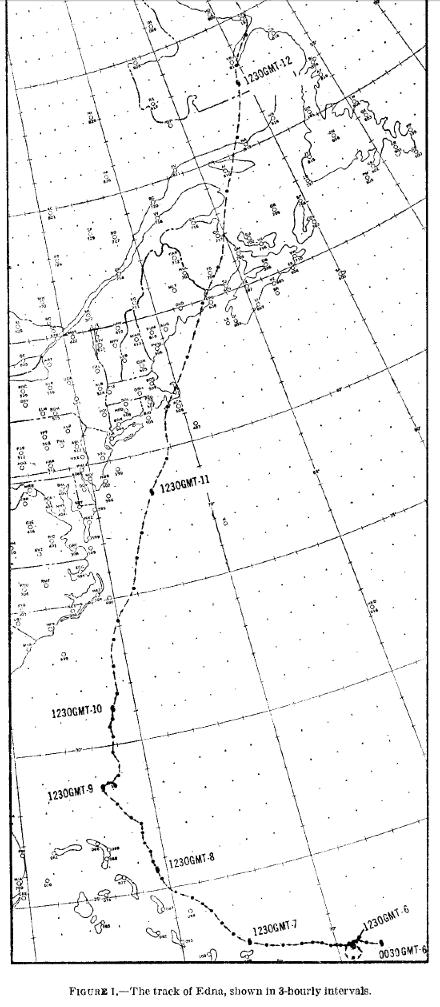
On September 11, 1954, Hurricane Edna was the right cross delivered to New England in the one-two punch of hurricane landfalls that year. Eleven days before, Hurricane Carol had struck the same area with high winds that had toppled trees and cut off power to thousands. Now Edna brought torrential rains that turned creeks into rivers and rivers into torrents. Many roads, rail lines, and bridges were washed away shutting down traffic in Maine. During its life, Edna caused US$43 million in damage and killed over 20 people.
Edna began as a tropical disturbance east of Barbados, but an organized circulation wasn’t detected until it had moved north of Puerto Rico. The depression was kept under surveillance by Hurricane Hunters as it moved northwestward to the east of the Bahamas. On Sept. 6th, tropical storm winds were observed and the system was named ‘Edna’. It followed a track similar to the Great New England hurricane of 1938 and the Great Atlantic hurricane of 1944, and turned to the north-northeast, brushing the Outer Banks on Sept. 10th. Like those previous storms, Edna began accelerating toward the northeast, reaching a forward speed of 45 mph (72 km/hr) as it struck Cape Cod. The hurricane made a second landfall in Maine and continued on through New Brunswick and Nova Scotia.
Hurricane-force winds were experienced along the coast with the highest observation of 120 mph (190 km/hr) being made at Martha’s Vineyard. A storm surge of 6 feet was recorded in Massachusetts and many boats in harbors were damaged by waves and flooding. But it was the heavy rain that caused most of the damage away from the shore. The highest rainfall total was nearly 7.5 inches. Edna was the costliest storm in Maine’s history with US$25 million in damage, mostly caused by the flooding.
The day prior to landfall, an Air Force Hurricane Hunter was scheduled to fly into the storm. The Weather Bureau’s Bob Simpson had arranged to accompany the flight on one of his ‘piggy back’ missions, where he used his summer vacation time to fly along on reconnaissance flights to make scientific observations of hurricanes. The flight’s takeoff was delayed for some last-minute additions, Edward R. Murrow and a CBS television crew. They flew along to film a segment to be broadcast on Murrow’s “See It Now” show. He interviewed the crew prior to the flight, including Simpson who made a plea for hurricane research. The program gave American viewers a first-hand look at what Hurricane Hunters did during such flights and why. Also, at the end of the show Murrow delivered his famous soliloquy, ”In the eye of a hurricane, you learn things other than of a scientific nature. You feel the puniness of man and his works. If a true definition of humility is ever written, it might well be written in the eye of a hurricane.”
This turned out to be the last ‘piggy back’ mission for Simpson. Hurricanes Carol, Edna, and Hazel of 1954 convinced Congress to allocate additional funds for the Weather Bureau to create the National Hurricane Research Project which assigned aircraft for the specific purpose of carrying out scientific research into hurricanes.
Some research papers about Edna:
- WILLIAM MALKIN and GEORGE C. HOLZWORTH, 1954: HURRICANE EDNA, 1954. Mon. Wea. Rev., 82, 267–279.
- Edwin Kessler III, 1958: EYE REGION OF HURRICANE EDNA, 1954. J. Meteor., 15, 264–270.
- Edwin L. Fisher, 1958: THE EXCHANGE OF ENERGY BETWEEN THE SEA AND THE ATMOSPHERE IN RELATION TO HURRICANE BEHAVIOR. J. Meteor., 15, 164–171.